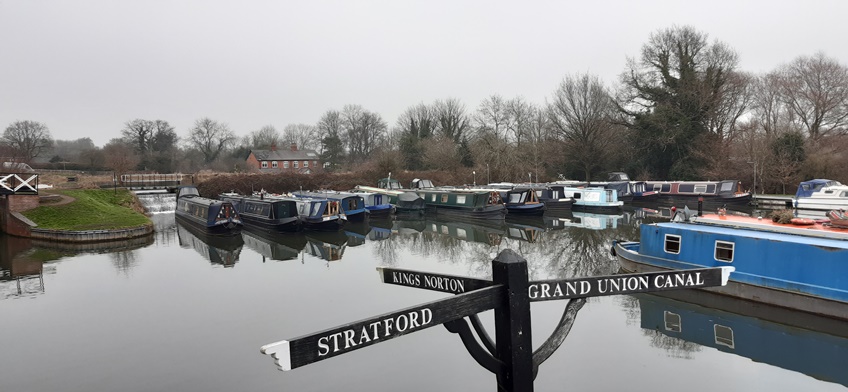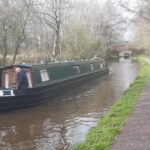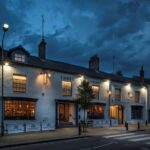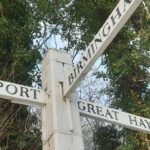The walkers now departing from platform two on the railway station close to the famous Cadbury World chocolate factory were not heading by train into Birmingham but out of a convenient side gate and by foot along the canal towpath to historic Stratford-upon-Avon!
But first, early on that cold and grey January morning, my walking companion and poet Peter Gibbs and I, had a brisk twenty-minute stride along the Birmingham and Worcester canal to its leafy Kings Norton junction with the Stratford canal.
This waterway with its fifty-six locks lowering the canal some three hundred feet on its twenty-five miles passage to Stratford was constructed between 1793 and 1816.
Its original purpose was for the transportation of coal from the River Severn to Birmingham but today it is a magnet for thousands of narrowboat enthusiasts being drawn towards Shakespearian Stratford.
Walking England’s amazing network of canals is always full of surprises and today was no exception when we suddenly came across a Guillotine Lock, the first we had ever seen.
Its purpose we were told was to maintain the water level between the two waterways but the truth, according to a local lady who happened to be passing by, was to stop the Birmingham and Worcester canal owners pinching water from their rivals who operated the Stratford waterway.
Now we were approaching the deep wooded cutting leading to the 322-meter long Brandwood Tunnel wide enough for two narrow boats to pass but with no towpath for walkers.
In former times, barges were pulled through by hand via a rail set in the brick lining of the tunnel while their horses were led over the top.
So, using Shanks Pony, we emerged into suburbia with absolutely no sign of that long-obliterated horse track of old and even a local dog walker didn’t have a clue as to which way we should go!
But following roughly along the line of the tunnel to a junction of roads, we crossed over and then noticed a footpath leading down an incline beside a row of houses and yes, we had found the remains of that long-lost track!
Why the local council had never thought to provide what must be many thousands of walkers with a few simple direction signs we could not imagine.
We began making our way gradually out into open country but not before we received an urban shock from what was billed as a village for the 21st century at Dickens Heath, namely a huge apartment complex together with a mock waterfall tumbling towards the canal.
Not long afterwards, we left the canal at bridge nineteen for lunch at the nearby Blue Bell Inn before crossing under the busy M42 and later diverting onto a lane to walk into Hockley Heath where we were booked in at the Premier Inn.
Early the following morning, we walked back into the village centre to pick up sandwiches from the Co-op but then walked around in a circle trying to find our way back onto the towpath only to discover it was a few steps away via a pub carpark.
With some thirteen miles to go to our next overnight stop and having already wasted some precious, time we picked up the pace to escape from the West Midlands into Warwickshire and were soon approaching the Lapworth flight of twenty-five locks all within two miles.
Every so often we had spotted small metal posts marking the distance travelled from Kings Norton Junction and, installed by the Stratford-upon-Avon Canal Society; founded in 1953 to completely restore and reopen all of the navigation from Lapworth to Stratford.
The completion of this huge task was celebrated in 1964 when HM the Queen Mother performed the re-opening ceremony.
It was here at the Lapworth flight we noticed that all the canal bridges had a slit down the middle which we were told was to accommodate the ropes needed back in the days when horses provided all the barge pulling power.
Shortly afterwards we reached the Kingswood junction with a linking arm of the mighty Grand Union Canal, which we’d followed for 137 miles all the way from London to Birmingham on an earlier winter walking adventure.
It was while walking on through open country that we chanced upon Solihull Ramblers members Tracey Harvey, Pauline Elliker, Carole Owen and Lin Sheridan, all extremely keen walkers, so naturally we stopped for a chat and an impromptu photo call.
Talking to the people we meet along the way is all part of the enjoyment on our cross-country treks.
Meanwhile, another unusual feature of this particular canal walk was the distinctive white painted barrel roof cottages where the canal builders had used the same wooden frames as they had for the small canal bridges.
It was at lock thirty-four, known as the Bucket Lock, in memory of an elderly lady who once drew water there, that we met the present occupier Paul Higginbotham who now surprisingly has a micro-brewery on the premises.
Now the so far quite restricted views began to open up as the canal shrugs off the last vestiges of the old Forest of Arden to emerge into the Alne Valley with journeys end in sight some six miles ahead beyond the spectacular 158 yard long iron Bearley Aqueduct.
We stayed the night in the village of Wilmcote now a destination for Stratford sight-seeing coaches because it was here that Shakespeare’s mother Mary Arden had a farm.
Unfortunately, our hosts at the inn, named after the famous lady, were not serving food at the time but they were more than happy for us to order a takeaway and have our supper in the bar.
Leaving just as it was getting light we completed the last three miles into Stratford in time for breakfast ….but not for the first time!
For we had stayed overnight in the town prior to setting out on the 123 miles long Shakespeare Way national trail which ends fittingly at the iconic Globe Theatre beside the Thames.
Then a couple of years ago it was an overnight stopover point on the 92 miles long Shakespeare Avon Way which, starting in Naseby, Northamptonshire, meanders its way through Leicestershire and Warwickshire to end at Tewkesbury in Gloucestershire.
But apologies for this ramble and returning to the current walk, we started it by staying overnight at the very conveniently positioned Old Farm Hotel just down the road from that railway station.
Pearson’s canal companion to the South Midlands is an essential for anyone wishing to follow in our footsteps.
Peter writes poems featuring our many walking and travel adventures and his book Let the Good Rhymes Roll is now available on Amazon.




